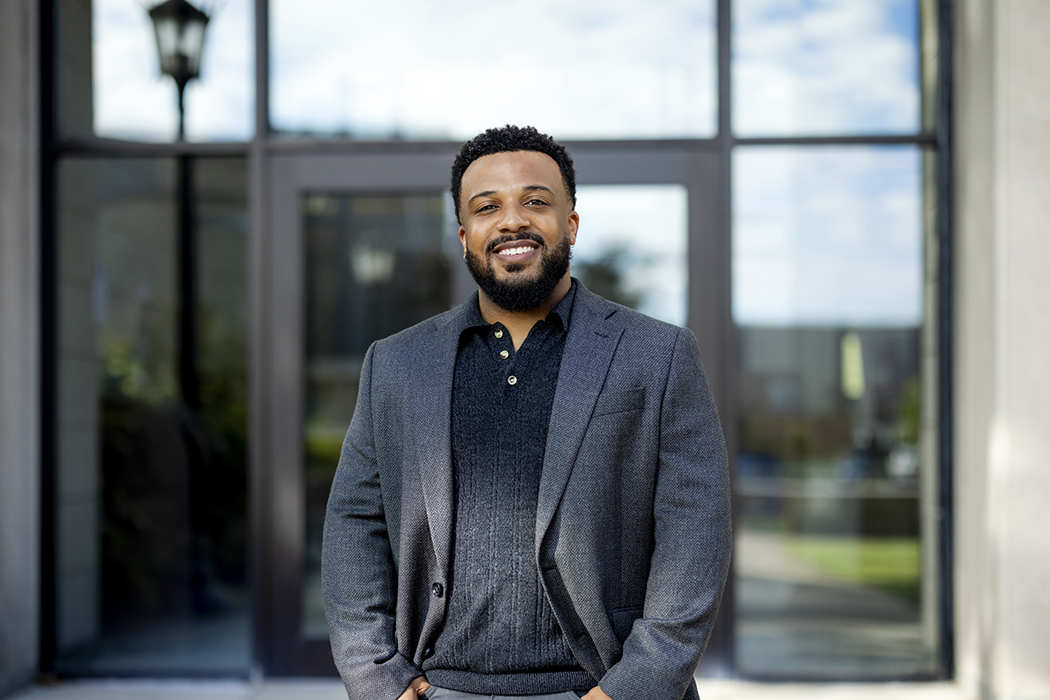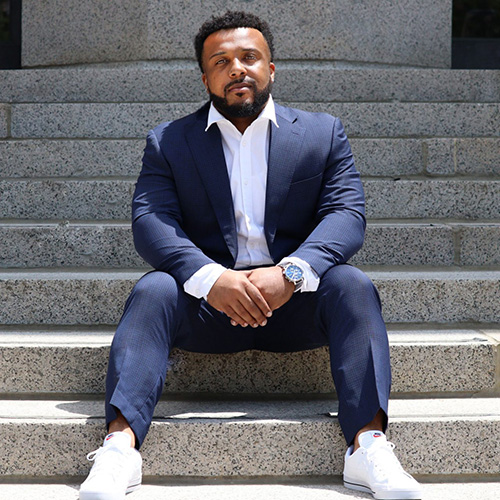
Ed-Dee G. Williams. Photo by Caitlin Cunningham for BC Photography.
For the past few years, Ed-Dee G. Williams has been working to design a virtual training program aimed at making it easier for Black youth with autism to seek help for depression from teachers and caregivers.
Last summer, he received a two-year, $160,000 grant from the Deborah Munroe Noonan Memorial Research Fund to evaluate the feasibility of the program.
Williams, an assistant professor at the Boston College School of Social Work whose research examines the interplay between race and mental illness, was one of a small handful of people in 2024 to receive a grant from the Noonan Fund, which supports research in Greater Boston to improve the quality of life for children with disabilities.
His intervention, created in collaboration with a software company called SIMmersion, uses video and speech recognition to make it seem as though users are having live conversations with teachers who are responding to their statements in real-time.
In actuality, users are talking to simulations of teachers, played by actors, who have been given scripts to provide a variety of typical but unpredictable reactions to what they say.
At each turn in the conversation, users select a symptom associated with depression, describe that symptom to a video recording of a “teacher,” and then receive feedback based on the response.
Each conversation is unique, so users can practice honing their conversational skills until they feel ready to share their stories with adults who can help them.
Williams envisions a future in which the training program is commercially available to schools, therapists, and parents, and he hopes to adapt the app to meet the needs of other populations, too.
“My goal is that anyone who wants to improve these kinds of conversational skills will be able to access this tool,” he says.
We asked Williams to reflect on the grant that he received from the Noonan Fund to support this work, with an emphasis on how he connected with the organization, what the application process was like, and why other faculty should build partnerships with non-federal sponsors.
Can you describe the study that you’re conducting with your grant from the Deborah Munroe Noonan Memorial Research Fund?
The Noonan grant is funding the feasibility assessment of my intervention, Asking for Help, a program designed to help Black autistic youth discuss their mental health with teachers and caregivers.
In collaboration with a software company called SIMmersion, we developed a simulation that allows users to have back and forth conversations with teachers. The teacher’s goal is to help users talk about their mental health, especially depression, while giving them the tools to communicate their feelings to their parents.
The grant gave us the funding to work with our partners and our community advisory board to recruit Black autistic youth, parents, autism advocates, and other specialists to test the program and provide quantitative and qualitative feedback.
Based on that feedback, SIMmersion made some big adjustments to the program. We knew it was a little wordy. We knew it was a little complicated to use. So we’ve streamlined it, making it simpler to understand, easier to navigate, and prettier to look at. Now we’re planning to test the new iteration of the program.
Did you respond to a specific Request for Applications, or RFA?
Yes. Shortly after I joined Boston College in 2023, Lisa Nowak, senior associate director of corporate & foundation relations at BC, contacted me. She was familiar with my research and asked if I had seen this grant opportunity from the Noonan Fund. It was specific to autism, she said, specific to Massachusetts, and she thought it would be a good fit for me.
We were planning to submit an application for an R21 grant from the National Institutes of Health, but receiving a grant from the NIH is always a long shot. So we thought this would be a nice secondary option.
What did the application process look like?
I first visited the website for the Noonan Fund to get a sense of other projects that had already been funded. I thought our project would fit in nicely, so I then submitted a six-page proposal focusing mainly on aims and goals. The application directed us to focus specifically on the implications for Massachusetts, so I had a doctoral student pull some facts and figures looking at autism policy in the Commonwealth.
We submitted our initial proposal to the Noonan Fund and the grant program let us know that our study fit its call for submissions. The Fund then asked for a full submission, which was a little more tricky, because we did not have a structured format to follow. We ended up following the strategy for pulling together a grant proposal for the NIH, where we limited each section of our proposal to a certain number of pages. One of the things with foundation grants is that the formats can be drastically different from the format for an NIH grant, but we figured it out and made it work.
Did you have access to other successful grant proposals so that you could see what worked?
Yes. The Noonan Fund connected me with another grant recipient and I talked with her on the phone for half an hour. She shared her aims and her research strategy and that helped a lot.
The website for the Noonan Fund also tells you what they want to see in a successful grant proposal, and Linda DeLauri, director of research and program development at BCSSW, helped us shape our proposal based on what the program wanted.
Did you have conversations with project officers between the six-page application and the full application?
We received feedback from reviewers between submissions, which helped us reframe some things. They wanted more information about the implications for Massachusetts, the number of participants we wanted to recruit, and our recruitment strategies.
Did you have specific partnerships already in place that you could leverage and integrate into your grant proposal?
Yes. Winston Kennedy, an assistant professor of physical therapy, human movement, and rehabilitation sciences at Northeastern University, and I had already talked about this project. So when this grant came across my desk, I asked him if he would like to be part of it, and he ended up being a co-investigator.
I had also developed some relationships in the community, including a partnership with the Black Autism Coalition. Since I knew the grant was Massachusetts-specific, I was able to write in the grant proposal that we have some really structured relationships with folks here in the state that will help us recruit participants and make sure we think about implications for the Commonwealth.
I’m curious about the deliverables for this study. Can you talk about those?
In our grant proposal, we laid out a goal of making this app free and accessible to communities throughout Massachusetts.
We're still working on where the app should be made available, which is part of the feasibility study. Should it be in the school setting? Should it be in the community setting? The home setting? There’s so much potential for where this could end up.
What was the timeline from when you submitted the grant proposal to when you received funding?
We submitted our initial six-page proposal in December. We found out that we were accepted for the full submission at the end of February. And then we sent out our full submission in April. A few months later, in August, we found out that we had been selected for funding.
What have you learned about working with non-federal sponsors through this process?
Compared to other grant processes I have gone through, I didn't feel the same stress of getting the science perfectly right and being especially detail-oriented. It seemed like the Noonan Fund was more focused on the big picture, with a special focus on the implications of our project. I also think getting initial feedback before we put together the full application was really helpful.
What have you enjoyed most about this process?
I think because the grant is specific to Massachusetts, I’ve felt a little more grounded. I’m doing work here for a foundation that’s here as opposed to trying to explain this for the whole of society. I felt connected to the state. I felt connected to the University because it feels a little more local.
After we received the funding, I’ve been able to say, “Hey, we’re funded by a local organization,” and I think community partners here like that we’re specifically thinking about them.
I also don’t feel like we have someone watching over us, which can be good or bad, depending on how you look at it. The oversight can be helpful, but sometimes as a researcher, you just want to get funded and go to work. So that’s been nice.
What was the most challenging part of this process?
The initial application packet that the Noonan Fund sent out said that the grant program gets something like 60 applications a year and funds about 10 of them. I immediately knew that I had to stand out among the other researchers applying alongside me. On the one hand, I felt more confident in getting selected because there’s less competition. But on the other hand, the other researchers are right here too, and I’m competing with people at the same University and in the same state. That was a little intimidating because I got a chance to see some of the people who’ve been funded and they’re all here in Massachusetts and some are working on some really strong projects.
Do you have any tips for other faculty as they consider working with non-federal sponsors?
Make sure your work is out there so people know about it. Publicize your data and think about how to translate your research so that it's accessible. I post a lot on Twitter, especially articles about our work. In one case, a feature on my research was picked up by the Curtis Center for Health Equity Research and Training at the University of Michigan School of Social Work, where I’m a faculty affiliate.





